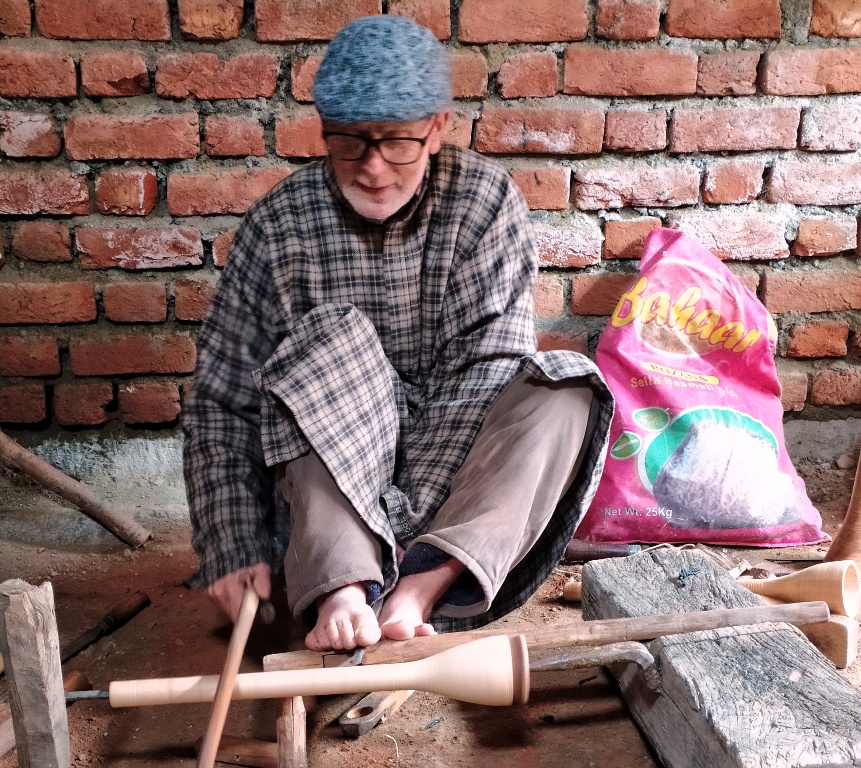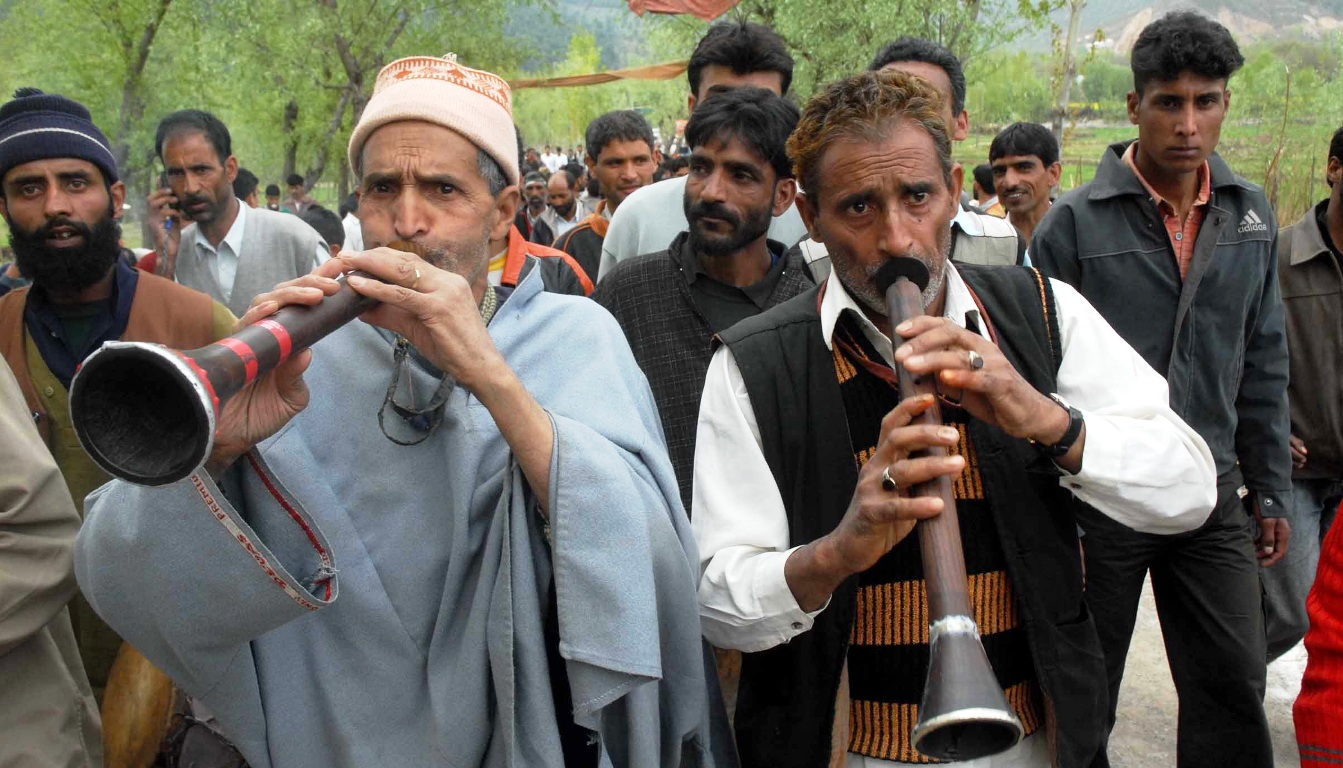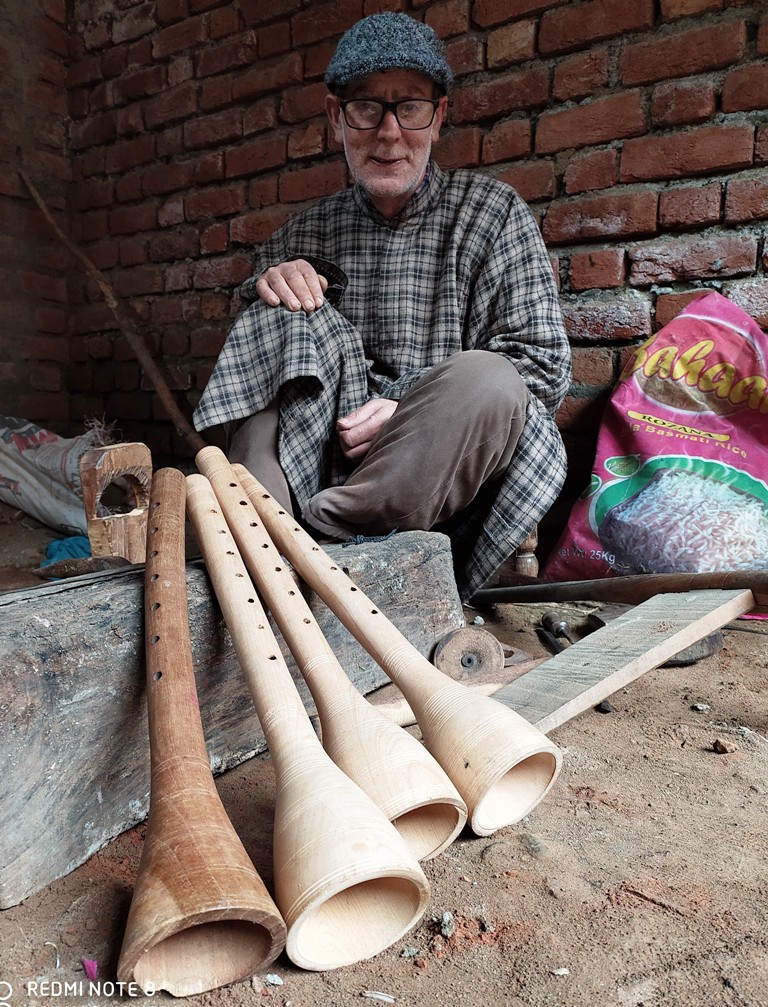An uncle and a nephew could be the last makers of Sarangi and Swarnai, the two key musical instruments of Kashmir music. There is no demand and there are no takers for the art to take it to the next generation, reports Farzana Nisar

Bashir A Khardi at work, a Swarnai in Making. But will he ever have a client, a buyer? KL Image Farzana Nisar
In a poorly lit shop, wedged between two tall buildings, just opposite the gate of a Sufi saint’s shrine in Kulgam’s main town, Bashir Ahmad Kharadi, 45, is busy in crafting a traditional Kashmiri musical instrument Swarnai, the traditional Kashmiri flute. Kharadi is drilling holes in a piece of hollowed wood as he hums the lyrics of an old melody. He is not making this instrument on the basis of an order by any client but to hone his skills. A shelf inside the shop has many such striking Swarnais organized in a row. He has made them years before.
“Although the instrument is not in demand nowadays and nobody has asked for it in many years, I still make it for my own happiness and satisfaction,” Kharadi said.
It is believed that the craftsmen of Kulgam were the only professionals who fashioned this traditional instrument in Kashmir and Bashir comes from one such line of Swarnai makers. Orphaned at the age of five, he was adopted by Mohammad Abdullah Kharadi, a carpenter. Many years ago when a man from Kishtwar had visited Abdullah and booked an order for making this instrument, he was unsure if he could make one. But once he started the process of making it, he was successful in his first attempt.

Two members of traditional Kashmiri Baunds playing Swarnai, the traditional Kashmiri flue. KL image Bilal Bahadur
Gradually the demand for Swarnais soared so high that he gave up traditional carpentry and focused on this instrument only. He then became famous as a professional swarnai maker among its players especially the folk theatre artists all over Kashmir. He practised this art for almost 50 years and used to get orders from all over Kashmir.
“My father was the first and the only artisan to make Swarnais. He made thousands of swarnais in his lifetime and people from different areas of Kashmir especially Anantnag, Pulwama, Budgam and Kishtwar used to take the instrument from him. He later learnt to play it too,” recalls Kharadi. “Before starting to make a swarnai, he would offer a ritual at the local shrine of Hazrat Mir Syed Simnani (RA), as he believed this instrument to be very pious.”
The Inheritance
Abdullah died in 2012 but before that, he had passed on the legacy of this craft to Kharadi. “Even though it wasn’t in my blood as I was his adopted son but I followed it by heart,” Kharadi said, as he picks up his chisel from the ground.
Interestingly, Kharadi did not directly learn the art of woodwork from his father. Rather he was initiated into this art by his mother, Hajira Begum.
Born into a family of carpenters in Kulgam’s Shurath village, Begum was the eldest among the three sisters. She would often accompany his father to the workshop, where she gained the basic knowledge of carpentry. After she married to Abdullah, who was also a carpenter, she gained mastery over it.
“She used to assist my father in making Swarnais, when he had lot of orders to make,” Kharadi said.
After passing his eighth class, Kharadi showed interest in learning the craft but Abdullah would often shoe him away from the shop and ask him to study. It was Begum then who taught her son the skills and also bought the tools he required.
Getting into the memory lane, Kharadi closed his eyes and literally transferred himself back in time, when he, as a kid, would spend hours sitting beside his father, see him work and later imitate him. The rattle of the busy street, hardly impacts his thought process, apparently indelible on his mind. “Although father never coached me about this instrument, I used to observe him while he worked on these instruments,” he said. “I was fascinated by whatever he did and always wanted to do the same.”
At 17, Kharadi crafted his first Swarnai that was highly appreciated by his father, who later sold it to a customer from a nearby village. Since then Kharadi has been making swarnais.
Not In Vogue
Highlighting the vanished demand for the traditional musical instruments, Kharadi said the last order that somebody booked for a flute was some eight years ago. Since then he hasn’t sold a single Swarnai. Seemingly, the atmosphere has changed and does not suit the music. It is silent and, maybe, sometimes wails and cries break the silence.
“There is a huge difference between the numbers of Swarnais I and my father made. His was a time when the demand for such instruments would range from Kashmir districts as well as the neighbouring states, but now this art is breathing its last with modern music taking the centre stage,” Kharadi laments.
Swarnais made by Abdullah would fetch him around Rs 400, while the same Swarnai today would cost a buyer Rs 3500. It normally takes Kharadi a day or two to make it. “No doubt I could earn a good amount of money out of it, but who wants traditional instruments now.”
In order to make ends meet, Kharadi makes wooden household items like big spoons (choanche), bowls, meat-pounder (goashe-ped), beater (dhyon), pestle (ch’oate) and other items which he then supplies to retailers in Srinagar. He also makes decorative egg-shaped balls used by papier-mache artists. “Swarnai making is just a hobby now; our main business is to make other items.”
Kashmir’s Shehnai
A special wind instrument, Swarnai is to Kashmir what Shehnai into the Indian music. This is the reason why Swarnai is also called as Shahnay by many Kashmiris. Swarnai is slightly bigger in size as compared to Shehnai, and has a strong metallic sound.
Musicologists believe the Swarnai has travelled from Iran through central Asia and reached Kashmir. The playing of Swarnai was considered very auspicious in Kashmiri culture and it was prominently used by the Bhands of Kashmir in their plays. During the harvest, the players used to go to the farms and perform to entertain the farmers and also collect the crop for themselves at the time of harvest, apparently in lieu of playing music to the farmer’s ears. It is played upon the mouth; musical notes are produced by blowing into it and putting fingers on the stops.
Swarnai is made in three parts, the nai or the wooden pipe that has nine holes, the barg – a reed of wheatgrass found locally and a copper disc into which the barg is fixed. “Even a minute change can spoil its musical tones, so to check the accuracy I ask a local Swarnai player and a Kangri maker, Abdul Jamal, to play it for me,” Kharadi said.
Not Alone
Kharadi is not the only one in the family who knows the art of making any traditional musical instrument. His uncle, Ghulam Kharadi, 80, has been a Sarangi maker. Initially, a Sarangi player, Ghulam used to accompany a local folk singer, Somnath to marriages. Once when he was in need of some money he sold his Sarangi and left singing. A few days later when he felt some emptiness in his life, he decided to try making a Sarangi by himself. That was the birth of an expert.

Bashir Ahmad Kharadi with his new Swarnai’s at his Kulgam shop. He makes these flutes for his possession, not for sale. KL Image Farzana Nisar
“I had been playing the instrument for years and being a chaane-koat (boy from the family of carpenters), it wasn’t too difficult for me to make one. I tried and was successful in my first attempt,” says Ghulam, with a smile on his wrinkled face. “My love for music made me a Sarangi maker from a Sarangi player.”
According to Ghulam, it would take him almost a week to complete one Sarangi, which he then sold at between Rs 1100 or 1200 Rs. Carved from a single block of wood, Sarangi has a box-like shape and is hollow from inside with two combined parts. It has three to four main playing strings and a number of sympathetic strings. It is played with a bow, made of the hard round stick of wood, which is moved from one end to another on the strings to produce sound.
“The sound of Sarangi is melodious but its crafting is equally delicate,” Ghulam said. “I preferred to make them using Arkhoal (a kind of wood found in the forests of Kashmir), which is a very difficult wood to work because of its skin-irritation properties.”
Ghulam has crafted about 50 Sarangis, which he used to sell to singers from adjoining villages. Being old now, he has left the work almost a decade ago. “Earlier people were very fond of traditional musical instruments. Marriages in Kashmir felt incomplete without the sound of the Rabab and Sarangi. But now when they have lost their sheen among present generations both the makers and players of such instruments have become vulnerable to extinction,” he regretted.
Proud Artists
While both Kharadi and his uncle Ghulam are proud of their craftsmanship, they lament that no one in their family has taken over this art. “I am the last one in my family to know this craft,” Kharadi said. “Nobody after me will ever carve any instrument.” He has a son and two daughters. His son, Omar Bashir, is busy with his studies and has refused to inherit this dying art. “I cannot ask him to learn this, as I know it won’t fetch him enough money to live.”
Ghulam has two sons, Mubarak Ahmad and Mohammad Ashraf. While Ashraf makes wooden domestic items, Mubarak owns a hosiery shop in the town. “I know my art will die with me, but I wish it doesn’t perish from the culture of Kashmir for years to come,” Ghulam said with a lot of pain in his emphasis on the sentence.
from Kashmir Life https://ift.tt/3bv0b0D
via IFTTThttps://kashmirlife.net
No comments:
Post a Comment